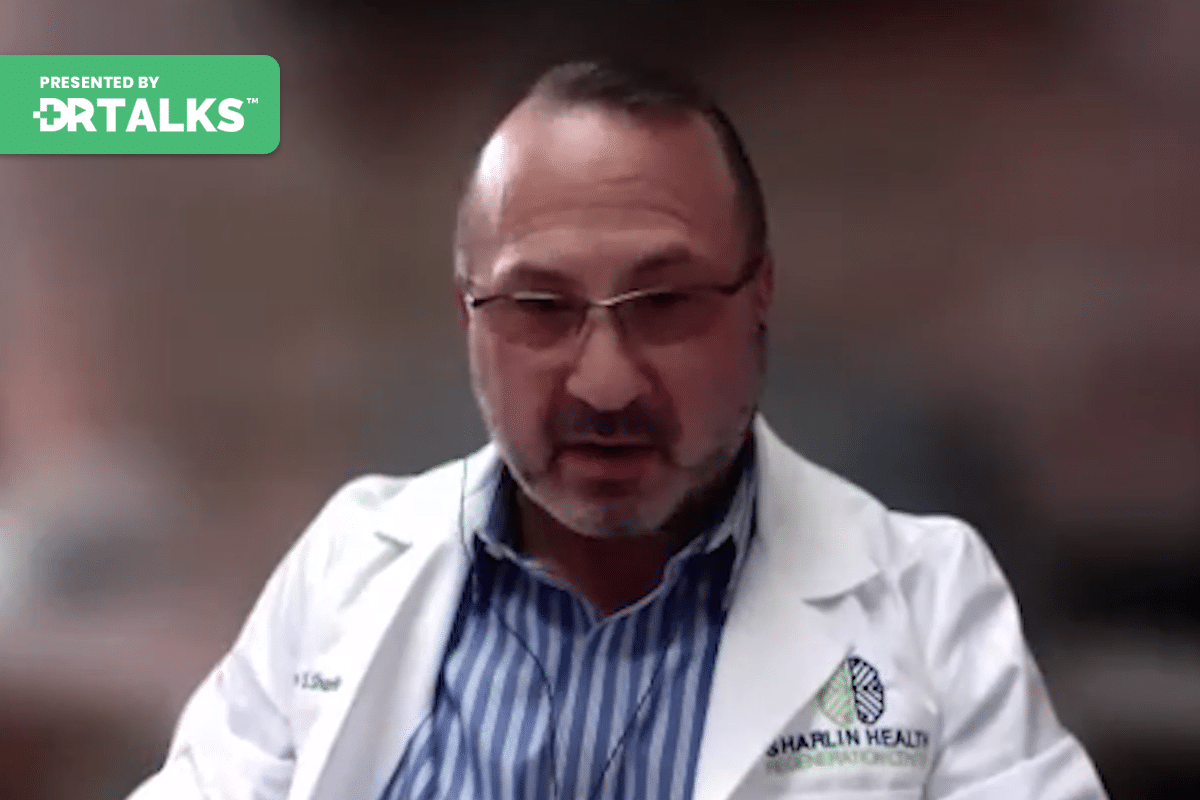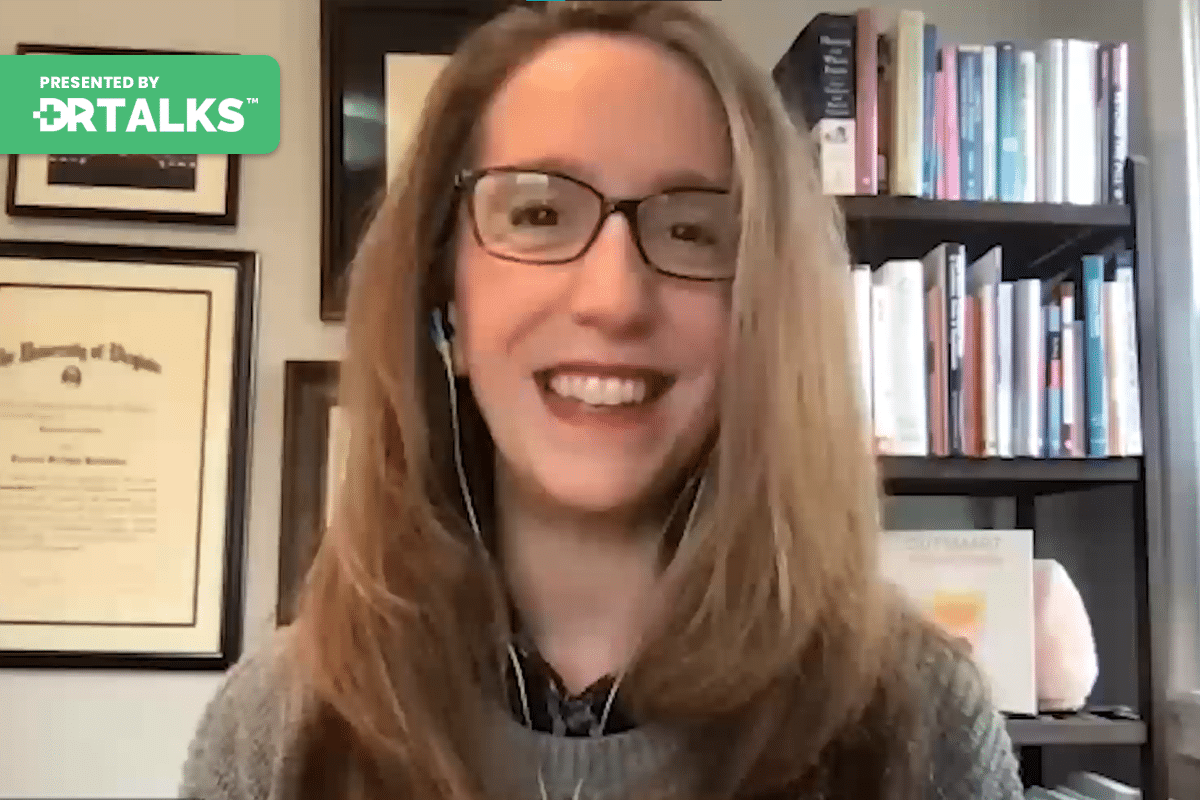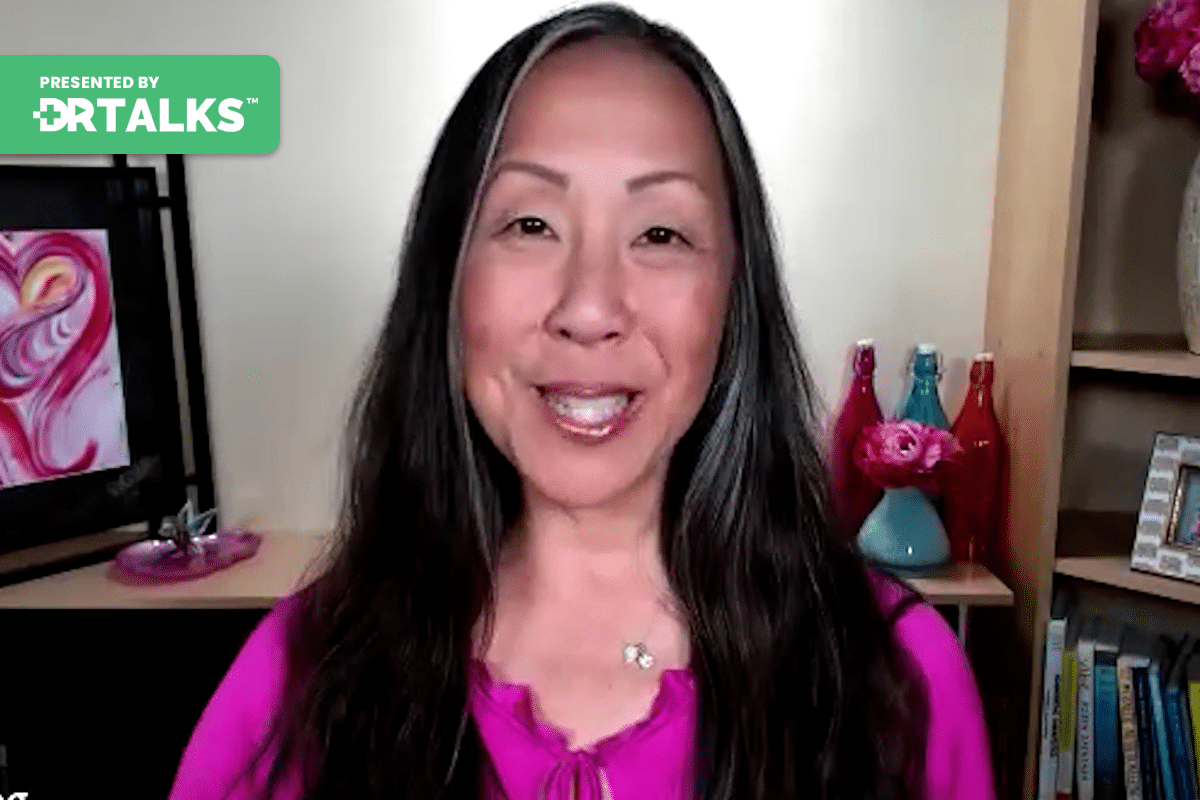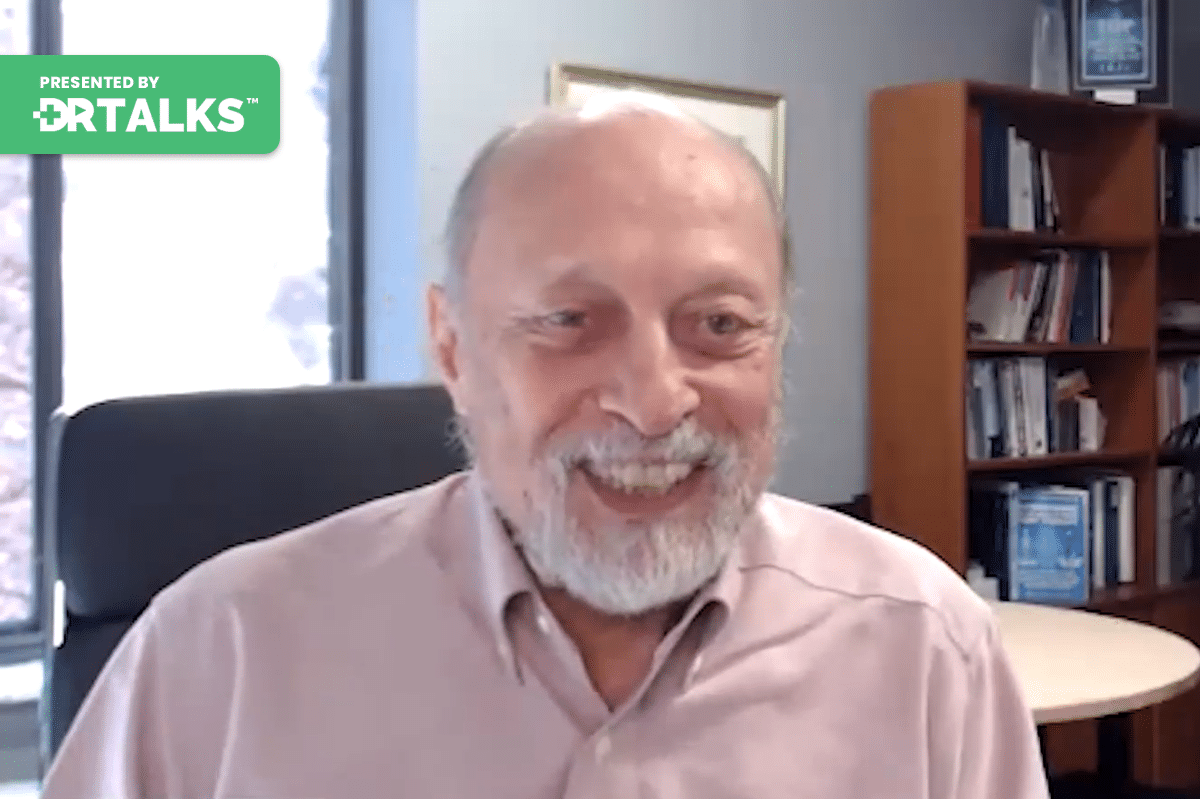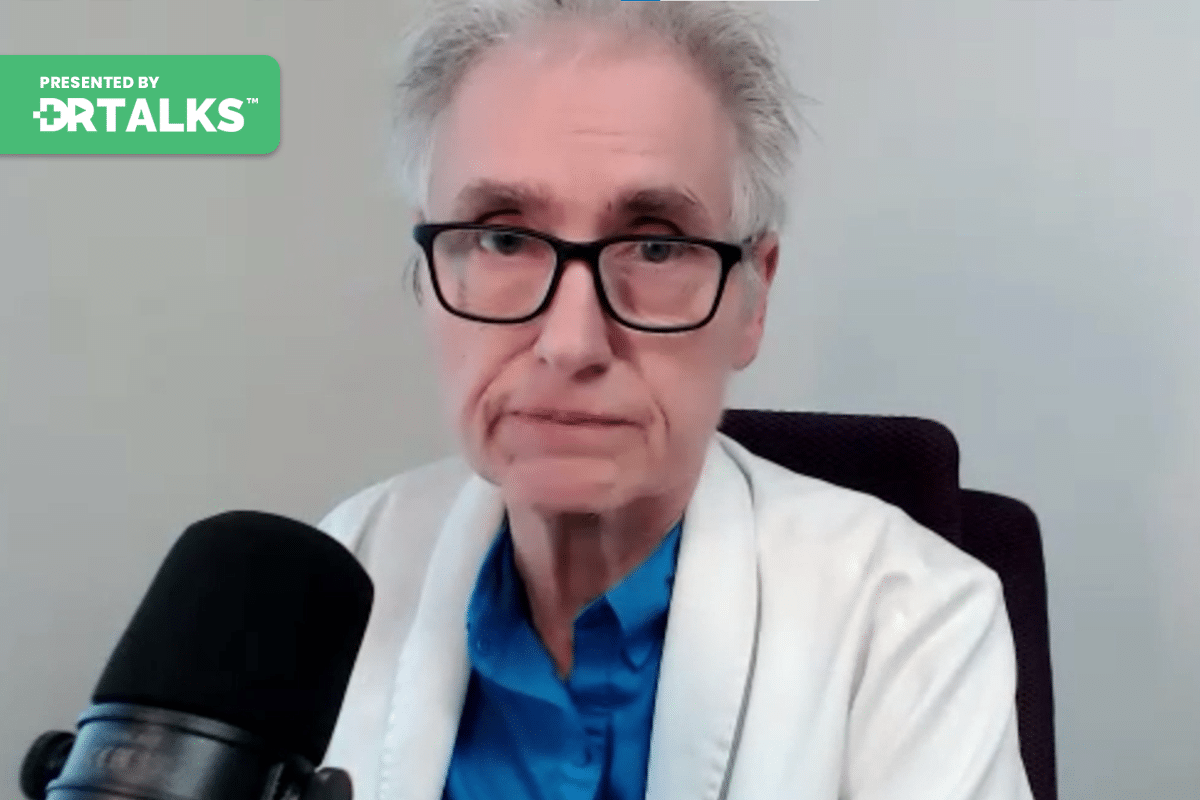Join the discussion below
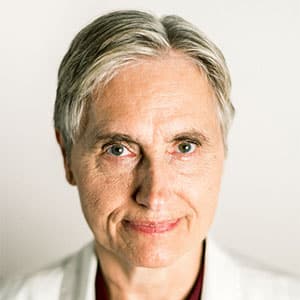
Dr. Terry Wahls is an Institute for Functional Medicine Certified Practitioner and a board-certified internal medicine physician. She also conducts clinical trials testing the efficacy of diet and lifestyle in the setting of multiple sclerosis. In 2018 she was awarded the Institute for Functional Medicine’s Linus Pauling Award for her... Read More
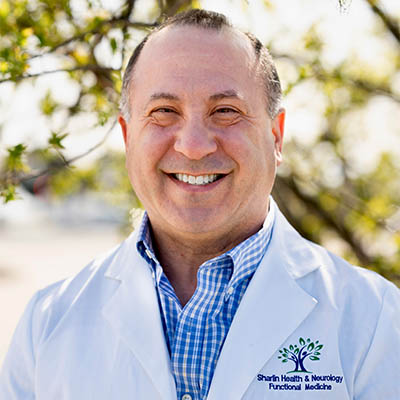
Kenneth Sharlin, MD, MPH, IFMCP
Kenneth Sharlin, MD, MPH, IFMCP, is a board-certified neurologist, consultant, functional medicine practitioner, Assistant Clinical Professor, researcher, author, and speaker. His medical degrees are from Emory University, The University of Virginia, and Vanderbilt University. His functional medicine certification is through The Institute for Functional Medicine. He is author of the... Read More
- Stem cells, particularly different types like hematopoietic and mesenchymal stem cells, hold promise in treating MS and other neurological disorders
- Understanding research terms like IRB, IND, and clinical trial phases is crucial in comprehending the progress and potential of stem cell therapy
- The FDA’s regulation of stem cell use and the future of regenerative therapies are key areas to watch in the treatment of MS-related issues
Terry Wahls, MD
Welcome, Ken. I am so glad that you agreed to be interviewed. Now, everyone, you should know Ken is a dear, dear friend of mine. I have immense respect for him, and he is where I send my most difficult cases. So, Ken, if you will, please introduce yourself and explain why you’re an expert in this conversation about stem cells.
Kenneth Sharlin, MD
I appreciate that. Yes, we have known each other and work together for many years now. What a blessing that is. And it started with my becoming interested in functional medicine as a traditionally practicing neurologist and realizing that the toolbox that traditional neurologists have is very limited. It’s generally going to be make the diagnosis, prescribe the drug, or send them to a surgeon or send you to a surgeon, as you know. And there’s so much more that can be done and should be done. And in some cases can obviate the need for some of the things that we use in traditional neurology. So we met through the Institute for Functional Medicine, and I remember the day very clearly like it was yesterday, and that started our relationship. We started collaborating with your summer seminar series, and I think I’ve been able to participate in every single one except the very first one that preceded our meeting. So hand in hand with that, about 2015, I started in health neurology in Ozark, Missouri, and it has grown from its original formation to being a series of businesses and services that we offer from traditional neurology with advanced cutting edge neuro diagnostics that in some cases you won’t find in other traditional neurology clinics to functional medicine, of course.
And we have a team based approach. So you will get all the support that you need from not just me, but from a trained and certified dietitian, health coach, neuro fitness. Everybody is well certified. We have quite a bit of clinical trial research going on here to give people opportunities to be on the cutting edge of medicine in that way. Think about 30 trials or so right now. We have on site imaging including and we might even talk about this 3-D automated 3D volumetric analysis, which is very critical, I think, to how we are moving forward with biomarkers in multiple sclerosis. We do have a neuro fitness center, but finally, we also have a regenerative medicine center as well. And regenerative medicine covers a couple areas that functional medicine does not typically cover. One is hormones. And although hormones are talked about all the time in functional medicine, a lot of functional medicine is about sort of restoring hormone balance. Right. If your hormones are disrupted, your adrenals, your thyroid. We want to understand why and functional medicine. And then we also want to understand what’s kind of keeping you on that trajectory. What are your mediators or perpetuators and get you back on track. But the fact of the matter is that for 100% of women and a very substantial portion of men, there’s this thing called menopause that women go through. And if that’s not a natural biological progression, it’s done at the hands of a surgeon is taking out your ovaries and your uterus. And unfortunately, many men have very low testosterone. It does get lower often as we get older. But that’s sort of like saying, well, you know, memory may get a little worse as we get older, quote, age related cognitive decline.
And I said, well, you know, that age is really an indirect measure of all the stuff that we carry with us in life. And, you know, there are many, many very bright, you know, older adults. So I don’t expect to lose my memory just because I’m getting older. And I don’t think you as a male, you should expect to have low testosterone just because you are older. But in regenerative medicine, we offer bioidentical hormone replacement therapy. And in a nutshell, you know, I would urge folks to be thinking about how these hormones are not just critical for reproductive purposes or for quality of life when it comes to intimacy, which, of course, is very, very important, but also for brain health. And I know you’ve talked a lot about that. So we there’s plenty of you know, there’s a growing amount of peer reviewed scientific evidence that suggest that we need to be returning to the idea that women should be on bioidentical hormone therapy around the time of menopause and then indefinitely for the rest of their lives to prevent neurodegenerative illness, including M.S., but also including Alzheimer’s, Parkinson’s, ALS and so forth. And then the same would be true for men. So we do focus on hormone replacement. And then the subject for today being regenerative medicine, stem cell therapy. I have an interest in what are called mesenchymal stem cells or stromal cells and how they play a role in the overall equation that is functional medicine.
Terry Wahls, MD
So, Ken, this is a great start. What’s the difference between a buzz and chemo stem cell and the bone marrow stem cell?
Kenneth Sharlin, MD
Well, those are for our purposes, those are largely the same. The so-called emcees. And there are arguments whether they should be called stem cells, stromal cells. One of the real pioneers of the use of these cells think they should be called medicinal signaling cells, in fact, and not stem cells at all. You know, we’re really talking about the same thing, but these mscs can be found in other tissues besides the bone marrow, such as fat, for example. And there is a history of extracting these tissues, I’m sorry, these cells out of fat tissue. Although due to restrictions by the FDA at this point, most of us who are following those guys guidelines and I certainly am we restrict are extraction of these cells to the bone marrow.
Terry Wahls, MD
Okay. So how how does one get it out of the bone marrow?
Kenneth Sharlin, MD
Right. And it’s important to understand, we use this term stem cell and probably by word, association, you automatically think, well, this is a cell that’s maybe some sort of immature primordial cell that can then mature into anything we want. It can ideally become nerve cells in the brain and or cells that myelinated nerve cells, right? So that’s sort of the dream, if you will, of stem cells. And there are all kinds of stem cells. Mainly, we could say they’re embryonic and non embryonic and we are not working with embryonic stem cells. There are also what are called induced pluripotent stem cells, which is largely in the arena of research, but the way I explain that is, you know, if you have a skin cell, a bone cell, a muscle cell and a retinal eye cell, in fact, all of these cells have the exact same genetic information. But it’s how cells turn on certain genes and turn off certain genes that allows them to become these specialized cells. And as you know, in transplant medicine, for example, the big issue is can you find a matched donor? So in the dream future, if you need a new heart, for example, we can harvest some of your skin cells, reprogram those skin cells to have them become Myositis heart cells, grow your heart in a special incubator and then essentially transplant you your new heart. That is your match to the donor because it’s you, right?
And all is good. That is a dream. And I believe there was a Nobel Prize award for research into IPS. TS But this is not in clinical practice at this time. That’s not at all what we’re doing. So most of the stem cells that you’re going to find, particularly in the United States or, you know, outside of the United States, places like India, China, the Caribbean, where some people go for cells, are going to be mesenchymal stem cells or signaling cells or stromal cells. And these are cells that are found in the bone marrow. Generally, they’re found on the inside surface of the bone. So we access part of the pelvic bone called the posterior superior iliac spine. And importantly, in the case of my clinic and again, hopefully in many other clinics, really the only legal approach to doing this in the United States, they are your cells. If you’re receiving cells from someone else or in some cases from some thing else. I’ve actually heard of people getting shark cells and all kinds of outlandish things. That is not that. Not only is that not consistent with that FDA guidelines, that those guidelines are in place because of safety as well as efficacy reasons, those are called allogeneic cells, meaning that they are not your cells.
So we are focusing on cells that are your cells. They are immune, privileged in the sense that they don’t trigger an immune response, but they are your cells. So in a typical scenario, what we’re talking about doing is bringing you into the clinic, making sure you’re well hydrated, providing some light sedation, what we would call conscious anesthesia. So you’re awake but comfortable laying you on your belly. So your pelvis is up and then using. In my case, I use ultrasound to identify the area of the pelvic bone, again called the PSA. Yes, we use numbing medicine typically lidocaine, sometimes with some epinephrine to minimize bleeding. And we use a device that is generically called a Jamsheed device. If you saw one, it would look like kind of like a giant ice pick. And this is why we use numbing medicine, of course. But after making a very small incision in the skin surface, just a couple of millimeters enough to introduce the Jamsheed, it’s usually only about 2 to 2 and a half centimeters to the surface of the bone, and then with some gentle back and forth rotation of the wrist, this device can be inserted into the bone marrow. And then there’s a second piece that goes in that sort of looks like a big straw. The Jamsheed is lifted out and the straw is left in place and we’re able to attach a syringe to the top of this device. We use specifically a device from a company called Insite, EMC T Corporation and they’re registered copy rated, what have you. Jamsheed is called the ASPIRE System. At any rate, this allows us to extract about 60 milliliters or 60 cc’s of bone marrow and then process that down.
Terry Wahls, MD
Hang on. People may not know milliliters, so it would call that about two tablespoons.
Kenneth Sharlin, MD
Oh, no. I would say it’s o altogether sticky html. I would have to ask Siri, I suppose, but I would say visually looking at it, it would be about the equivalent of it looks like maybe about a cup full. It’s a fair amount of bone marrow when we’re all done, you.
Terry Wahls, MD
Know, all done.
Kenneth Sharlin, MD
But there’s plenty of bone marrow to spare. So we’re not drying you out or anything like that.
Terry Wahls, MD
If people were donating blood, we donate about a pint of blood. So at a time. So while a cup sounds like a lot, we easily could replace all of that.
Kenneth Sharlin, MD
Yeah. Yeah. So it grows back fairly quickly and it’s important to understand that we do need at least that much because we are not in any way culturing the cells. We need to get as many cells as we can and only a small proportion of the bone marrow cells extracted are actually going to be these stem cells. Most of them are red blood cells and white blood cells and so forth. The nice thing about this system that we use, it’s it’s called a closed system. And that basically means that at the time that the bone marrow is being extracted and we’re extracting into a sterile syringe, of course, I’m gowned gloved patient is draped. That’s an entirely sterile field. And at no time does the bone marrow have contact with the air or human fingers. So the bone marrow is taken from syringes and then put into a separate system provided to us by site, by way of just screwing the syringes on and, you know, pushing the plunger so that it empties into the main tube. And then that tube goes into a centrifuge, which is a device that spins the bone marrow very, very, very fast to separate out the different types of cells, ultimately allowing us to asprey just the layer that is the stem cells. So out of 60 milliliters or CCS, you’re typically going to get about, oh, about 5 to 6, six and a half at the most. CCS. And so really only talking about 10% of that total volume in seeds.
Terry Wahls, MD
And then once you get these medicinal signaling cells or stem cells, what happens next?
Kenneth Sharlin, MD
So we are focusing on treating diseases of the central nervous system, primarily M.S, ALS, Parkinson’s disease and Alzheimer’s disease. That means that the cells themselves have to be introduced to the area that we want to help out. And in this case, we are laying the patient on their side, rolling them up into a little ball. And at your many of your mass patients will know. I’m talking about a lumbar puncture. So they’re laying on their side. Their knees are up near their chest. We can identify an area of the lower spine in between the fourth and fifth lumbar inner space, again, numbing up the skin. This is a region called the lumbar cistern. So to reassure you or your followers, those who are listening to this summit, we are nowhere near the spinal cord in this case. So this is where the spinal fluid pulls at the lower end of the spine. And again, using numbing medicine. And I’ve done thousands upon thousands of lumbar punctures as a neurologist only. It’s kind of the opposite of the lumbar puncture, because we’re not so much removing fluid as we would in the lumbar puncture, although I do do remove a small volume, but then I replace that volume generally with the six, six and a half cc’s of these stem cells. And because I’ve generally I’m going to be taking out somewhere around 12 or so CCS altogether of spinal fluid. I’m then flushing those stem cells we use sterile, normal sailing to essentially push those cells into that lumbar cistern. And then immediately after words, positioning the patient on their back legs higher than their head to encourage the circulation of these cells toward the central nervous system, i.e. the brain and the spinal cord.
Terry Wahls, MD
And how long will they be in that position?
Kenneth Sharlin, MD
We like them to be in that position for 2 hours now. This is like a mini surgery center, right? So it’s a clinic. You’ll have several of my staff with you. We’re taking vital signs. We’re making notes. How are you doing at that point? You probably haven’t eaten all day. You’re kind of hungry. And if we feel like it’s okay, we’ll, you know, make sure you have a wall certified snack and eat some sauce and fluids are going and we have a pre and post treatment medication protocol that we use to keep our patients comfortable and minimize the likelihood of any issues there. Really, this is a this type of procedure is well published in terms of safety. So we know we have not encountered any serious adverse effects and we feel very confident that we won’t encounter any serious adverse effects about the most common problem that people have afterwards is they can have a little bit of discomfort kind of in their buttocks and upper thigh area that feels kind of like what you would call sciatica. We make sure that they’re comfortable with some pain medicine and we’ve actually figured out why that happens. It’s well-reported that it can happen, but we’ve got a few tricks up our sleeves to even minimize that. But that’s a little inflammation of those nerve roots that are in the low back and that generally resolves within a couple of weeks. So but then it asks why? Why bother to do all of this, right? So we can just a review. We’ve extracted bone marrow, we spin it down, we separate out the stem cells, we introduce them through the lumbar spine, the low back into the spinal fluid, where they can then migrate to the spinal cord and brain. So these are not cells that we think generally are going to differentiate into new nerve cells. That’s not really their job in the body and in the brain. And we have bone marrow in the skull.
So an important component for understanding this is the concept that we are using cells that have a homologous and that’s the technical term, homologous use in the body or a homologous role. We’re not really doing something different. In other words, and your body already does, we’re just sort of turbocharging it. So if you have injury or inflammation within the central nervous system, these cells normally migrate out of the bone marrow in the skull. They are activated by your spinal fluid, which is then more than just a cushion for your brain and spinal cord. But actually the spinal fluid is biologically active. It’s the environment that influences the cells. It says, hey, there is injury, there is inflammation. This is a central nervous system. We need to coax you, if you will, into secreting nerve growth factors, micro RNA and other types of growth factors that then participate in the healing process.
Terry Wahls, MD
And so we’re we’re getting growth factors going. So it’s nurturing the immune system in the brain to be in a more reparative state?
Kenneth Sharlin, MD
That is correct. That is correct. And that’s what pairs this so well with functional medicine. You know, it’s sort of the heavy foot on the accelerator, if you will, that if you’re doing the diet, if you’re doing the movement program, if you’re if you have your stress resilience practice in place, if you’re taking your targeted supplementation and optimizing your antioxidant and supporting your mitochondria, you know, what else can you do to push things in the right direction? Well, you could get an infusion of mesenchymal stem cells. And based on the current science and what’s been published, I always quote the data from Brainstorm Cell Therapeutics that is published their Phase two clinical trial for Progressive. Then this as well as published their phase three trial for ALS. And they have a whole pipeline of other, you know, diseases or conditions that they are studying, whether they’re always using the same product. That product has the trade name neuron or MSE MTF, which mesenchymal stem cell neurotrophic factor. But this is well-recognized now at this point to have a very positive influence on the central nervous system in terms of healing and repair.
Terry Wahls, MD
Now, can one of the things that I am seeing are we have a lot of stem cell tourism going on, people going to a wide variety of international locations to get their stem cells. And my impression is that this centers may be expert at stem cell harvesting and delivery, but I don’t have any sense of whether or not they have a functional medicine approach towards optimizing the environment. Do you have any experience with any of these other stem cell types of international treatments?
Kenneth Sharlin, MD
I do actually have some limited experience with them because we have several folks that have been to some of these places or spoken with representatives from some of these places. And some are very, you know, fairly transparent in terms of you can look them up on the Internet and they’ll, you know, tell you a little bit about what they’re doing. But I would agree and our experience with them is that, first of all, they are not doing anything that’s functional medicine. So, you know, if you have what do we say in AFM and you know, if you have a bucket of muddy water and you pour clean water into the muddy water, you’re really not going to have, you know, clean, purified water. And in the end and so that is my concern. If somebody is just, you know, very, very determined that they absolutely want to be treated with stem cells and they know that we’re not you know, they’d say, no, I don’t want to do fine. I’m going to do my own program. I’m following this or that on my own with some reservation. And if we feel like they’re appropriate candidates, we’ll say yes to that. But by and large, the vast majority of folks who are getting stem cells from us are also doing functional medicine. So that is one thing. You know, there is one advantage potentially to going outside the United States, and that is we are not allowed to manipulate these cells in any way. We are not allowed to culture them, grow them, etc.. But that’s very much a black box. And I guess their number one good reasons why we can’t just do that in the United States. And that is because we depend on evidence based medicine for safety and for efficacy, for proven efficacy. So there are a lot of things that are going on.
Terry Wahls, MD
And we should define efficacy. People listening may not know that term.
Kenneth Sharlin, MD
Well, efficacy or effectiveness, and that means ideally in a placebo controlled or active controlled trial where there is appropriate blinding meaning that the treatment providers as well as the recipients of the treatment, do not know what they are getting or giving in order to minimize the likelihood of what we call bias. Meaning, I really want to show that my treatment works. So I’m going to convince myself, no matter what, and the way I sort of report my results would lean toward supporting that treatment. Whether or not there’s really, truly a treatment effect.
Terry Wahls, MD
Important to know efficacy, effectiveness, those are great terms. So I mean, I think stem cells are really very interesting. The research continues to look very favorably on the benefits of stem cells. And my interpretation is if you do stem cells without addressing diet and lifestyle, if you’ve spent a lot of money and you really sabotaged your results.
Kenneth Sharlin, MD
And some of these out of the United States places charge an exorbitant amount. You know, I’ve heard 30, $50,000 for stem cells. You know, our fees are nothing like that. You know, we can do it. It’s not cheap, of course, because there are costs involved, but it’s certainly not 30 or $50,000. So that’s very important. And, you know, and we can offer a functional medicine services. We do have results that we can share. We are not done a large scale clinical trial. We are not required to do a large scale clinical trial because we were following specific FDA guidelines that allow for this type of treatment in an individual. But we cannot claim that the treatment with these cells has been proven to treat their disease per se. We can’t say my stem cells are to treat your MSA or to treat your ALS.
Terry Wahls, MD
So your stem cells would be for what then if they’re not to treat disease, what do you say? Someone you know, because we’ll have thousands of people sitting within your immune condition who are probably now curious. It’s okay. I want the stem cells to treat my new immune condition.
Kenneth Sharlin, MD
Right. Well, what we say is, you know, that the cornerstone of really what underlies much of these chronic neurological and neurodegenerative diseases is inflammation. There is inflammation and there is injury. And what we are doing from an equally functional medicine perspective, because functional medicine itself is not a proven treatment in the sense that the context we’re talking about is that we’re addressing root causes. We’re addressing the mechanisms of disease, apoptosis or programed, cell death, chronic inflammation, secondary to microglial activation, for example. So we know that the science tells us that these cells have a very definite role to play in these mechanisms. And as much as we would use a functional medicine approach, whether it’s walls, whether it’s the Charlatan Brain Tuneup program, we can use these cells and we can freely talk about the role that these cells play in these biological situations.
Terry Wahls, MD
So I think what I’m hearing you say is, no, we’re not treating your disease, but we are improving physiology. We are communicating with your immune system. And then your body’s going to do what it can with the resources you’ve just given it. But would that be a fair description?
Kenneth Sharlin, MD
That’s right. And it again, if you want to use another analogy, and I’m sure you get these questions all the time, Dr. Wahls, should I take this supplement to treat my M.S. right? Well, yes, maybe no, maybe not. You know, what are your levels? What do they look like? You know, do you need that individual nutrient because your cells depend on that nutrient, whether it’s your mitochondria or other parts of your cells, you know? But has it been measured and do you need it in order to support normal cellular biology? Right. But we can never say that, you know, this vitamin D is proven to treat mice or proven to treat Parkinson’s disease. But it certainly aids and supports.
Terry Wahls, MD
And we could talk about how to support physiology.
Kenneth Sharlin, MD
Right.
Terry Wahls, MD
I can talk about how to create more health and vitality. But I’m very careful that I am not treating disease. I let the other prescribers treat disease. I just work on improving health and vitality.
Kenneth Sharlin, MD
I’m very blessed to never have heard the words you have there. Ness You know, I am in the position many times to use those words with my patients and to explain the unfortunate circumstances that they’ve found themselves in. But what I’m getting at is that we hear those words. We often search for hope and there is good hope and there is sort of bad hope. Right. And the good hope is that we can incorporate the principles of things like the Wahls protocol because it’s sound, it’s based on science. And there is in fact some evidence based medicine that support because you’re doing the work, you know, they’re in Iowa City to show that, you know, following an anti-inflammatory, you know, low carbohydrate diet, for example, that is nutrient dense and so forth, is healing to the body. But what we don’t want to do is grab on to false hope. And unfortunately, too often what happens with these stem cell centers is that they are peddling false hope and they are using words that are that we use in the industry of research. Both you and I do research like they will say that they have I the approval or that this is an investigational new drug.
Well, during COVID, the FDA allowed for they were so desperate to find treatments for COVID that there were many companies that actually got in the approval to investigate whether it was their stem cells or exosomes, which is a separate discussion. But by the way, completely in violation of the FDA at this time. But they have this approval to investigate their product for, say, COVID related pneumonitis. But that doesn’t mean that you can just go out and use your product for multiple sclerosis. But when you use it says I, the approval, it makes it sound like it’s approved for and this. But it’s not right we I RB Approval and institutional review board. That just means that there’s an ethics committee that said that your proposed research falls within human research guidelines of good clinical practice. It doesn’t mean that your treatment is approved or is is proven to be effective and safe for the disease under investigation. So things like that are very, very tricky. And unless you’re in the industry often folks don’t really understand and those terms are thrown around and it makes people believe that they’re getting something that they’re really not.
Terry Wahls, MD
People can be misled because they’re desperate for hope. So you’re one of the few places in the country doing stem cells in your office? I asked part of a supported program for a wide variety of new neurological issues. Again, the list was M.S..
Kenneth Sharlin, MD
ALS, Parkinson’s, Alzheimer’s. Those are really the things we’ve focused on. So what we are seeing, for example, with our ALS patients, ALS patients know that when they go see the doctor, the doctor does something called the ALS functional rating scale. It’s a measure of how well they’re doing clinically with their ALS, and it’s the maximum score that you can get is about 48 points. And statistically the scale goes down about 0.8 points per month. ALS has about a 20% five year survival rate. So our patients who are getting these treatments over the course of several months, what we’re seeing is their ALS functional rating. Scale score is not going down or is maybe say over six months it goes down one point when it should have gone down point eight times six or 4.8 points. So we’re seeing slowing of disease progression. We’re similarly seeing this with their mass, whether it’s their EdSource, their extended Christy disability rating scale or their relapse rate or terms of changes on the MRI, patients are achieving disease stability. We’re definitely seeing improvements in our Parkinson’s patients. I give a type talk on this subject and we’ve got a couple of nice videos of a patient of ours who has received stem cells, who happens to be a doctor by the way, and has had Parkinson’s for over 30 years. And he’s, you know, just over the top. And you can see how he’s walking after he gets his stem cells.
Terry Wahls, MD
Thank you again. That was a fabulous, fabulous interview. And now, again, to everyone who’s listening. Can was our very first a certified was protocol practitioner. We have been training health professionals around the globe for several years now. Train them how to use the Wahls Protocol to manage patients with multiple sclerosis and other neuro immune conditions so they can have the best chance at stabilizing their disease and regressing disability and regressing their symptoms again. We’ve been training other physicians and other health professionals all around the globe to utilize the concepts that I teach and the concepts I use in my clinical research to stabilize patients with multiple sclerosis and other neuro immune conditions. Not everyone can come see me, but you can come see one of the trained Wahls Protocol practitioners and Ken is where I said people that I don’t have time to see myself or that we send people who have the most serious, most difficult cases. Again, Ken, thank you so much for having such a wonderful interview and for all of the great work that you were doing.
Downloads

